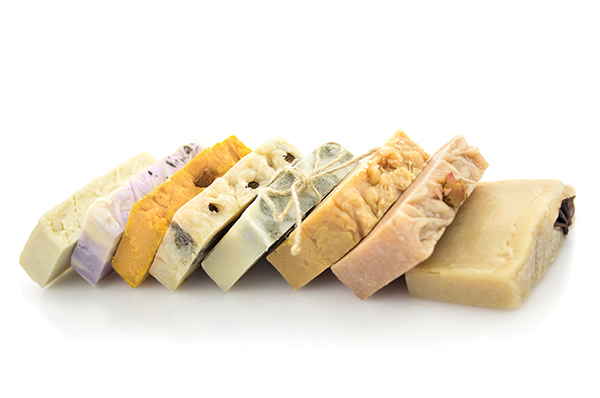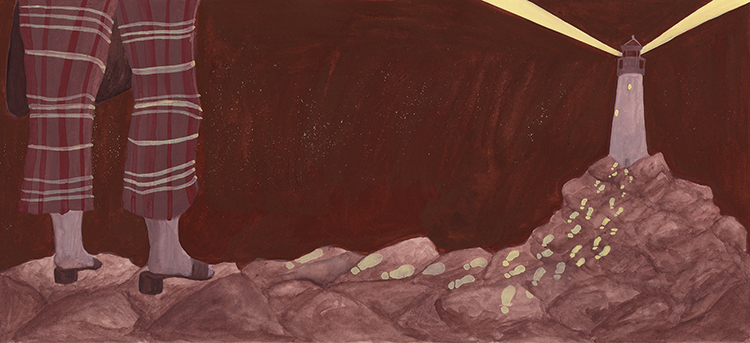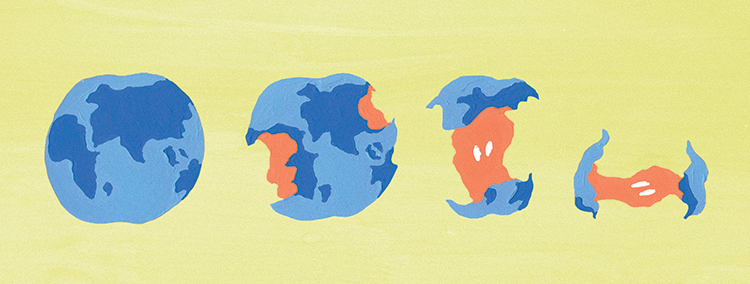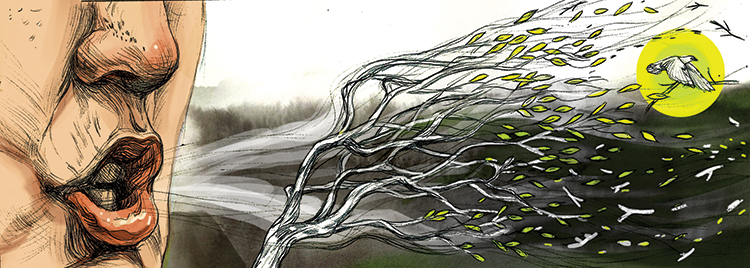Clean and Simple
by Anna Herman
Soapmaking is a blend of art and chemistry, and you shouldn’t take the chemistry part lightly. Once you understand the basic chemical process, you will see the importance of taking precautions. Then you’ll learn the many possible combinations ofingredients, and your inner artisan can emerge.
I have come to rely on handmade small-batch soap to both cleanse and moisturize. This may seem like a contradiction, but when made well with quality oils, this is exactly what good soap can do.
The process that transforms liquid oils into a solid, skin-nurturing bar of soap requires goggles, gloves and a well-ventilated room. The key ingredient is pure lye—an extremely caustic alkaline substance that one could also use as drain cleaner. It can be found at most hardware stores—don’t get drain cleaner that has other ingredients besides 100 percent lye. Lye should be treated with the respect strong chemicals command. That said, a pair of chemical-resistant gloves and goggles will set you back only about $15. Don’t be afraid—just be prepared.
The art of soapmaking is in the blend of oils, the botanical or edible “add-ins” such as calendula petals or oatmeal, and the shape.
First, each oil has its own particular attributes, which can be explored at
lovinsoap.com/oils-chart. While some modern soapmakers still use the once common animal-based lards and tallows (bear, beef or deer) in their soap blends, most choose nut, seed or fruit oils for their lather or skin-softening benefits. Your blend will likely be based on availability, affordability and desired use. Coconut oil is easy to find and makes great lather, but it can be drying to skin if used exclusively. Olive oil is less cleansing, but is mild and moisturizing. Some oils contribute hardness to a bar, and others are best for sensitive skin. My standard recipe is based on a mixture of organic coconut oil and olive, sunflower or safflower oil.
Botanical elements such as herbs (sage and mint) and flowers (calendula) from the garden, ingredients from one’s pantry (oats, cornmeal, dried orange peel, poppy seeds) can add texture, abrasion or soothing properties. Many natural clays, ground spices (turmeric) and dried petals and roots can be used to color and add specific healing properties to your bars. Visit Mountain Rose, mountainroseherbs.com, for many excellent botanical options. For scents, use only quality essential oil rather than the synthetic “fragrance oils.”
For molds, you can use silicone baking pans, half of a waxed milk carton, or candy or candle molds if you’d like to make something a little more fun—especially if you plan to give your soap out as gifts.
My favorite “gardener and cook” soap is a mix of organic raw coconut oil, sunflower oil that has been infused with calendula petals with oats, cornmeal and sage along with lemongrass and lavender essential oils. Cleansing, moisturizing, soothing.
My hands were as happy to make it as they were to use it after a day of picking weeds.
Making Soap
The science of soapmaking (saponification) requires precise measuring. You need the proper ratio of oil to lye and water to completely react all the caustic lye and leave just enough unreacted oil leftover for emollience. Bramble Berry, a soapmaking supply company, has an online calculator I trust to create foolproof recipes with whatever oils I have on hand.
During soapmaking, you create a chemical reaction that creates high heat and caustic fumes, so in addition to your basic recipe of oils and lye, it’s important to have the right gear and a well-ventilated space.
What You’ll Need
• An immersion blender
• A well-ventilated room
• Heat-safe mixing containers (a canning jar will work)
• Chemical-safe gloves
• Safety goggles
• A cooler and wool blanket
The Process
1. Goggle and glove up, measure your ingredients, have molds ready, and turn on the exhaust fan or open a window.
2. Add the measured lye slowly to the weighed or measured water (or desired liquid). Stir and let lye water sit. Remember: Always add the lye to the water and not the other way around! This is an exothermic (heat-generating) reaction, and this lye water will get extremely hot. Be sure to use a heatproof container, such as a canning jar.
This lye water will smoke and send off fumes, which is why room ventilation is important. Let the lye water sit (I leave it in the empty sink) while you measure and assemble the remaining ingredients.
3. Weigh and mix the oils in a large nonreactive (stainless steel) bowl. Melt any oils that are solid at room temperature (such as coconut or palm) to liquid state (over a pot of hot water, double boiler style).
4. Add the lye mixture to the oils and use the immersion blender to blend. Within 5 to 8 minutes, the mixture will thicken and become opaque. Once it is the texture of thin pudding or cream sauce, it is considered to be “at trace.” This is the point where the oils and lye mixture are well emulsified and the saponification reaction is well underway. Depending on the oils, the temperature and other factors, this could take up to 15 minutes, but is usually done within 8 minutes.
5. Mix in any desired add-ins such as lavender leaves or oatmeal with a nonreactive spoon. Remember that whatever utensils you use will need to be either reserved for soapmaking or very well cleaned before putting back into kitchen rotation.
6. Pour into a mold. The soap mixture will continue to generate heat as the reaction continues. Contain this heat by placing the molds in an insulated box (Styrofoam or a cooler wrapped in a wool blanket) overnight.
7. Unmold your soap. The saponification process continues for days, but it can be safely unmolded within a day or two. If you used a large mold, slice the soap within two days before it hardens and may become too brittle to divide.
8. Cure before use by setting the soap on a rack for at least 4 weeks. During curing, some of the water will evaporate, and the soap will become harder and milder.
9. Enjoy your soap!
Anna Herman is a garden educator who raises chickens, ducks, bees, fruits and veggies in her Mount Airy backyard.








